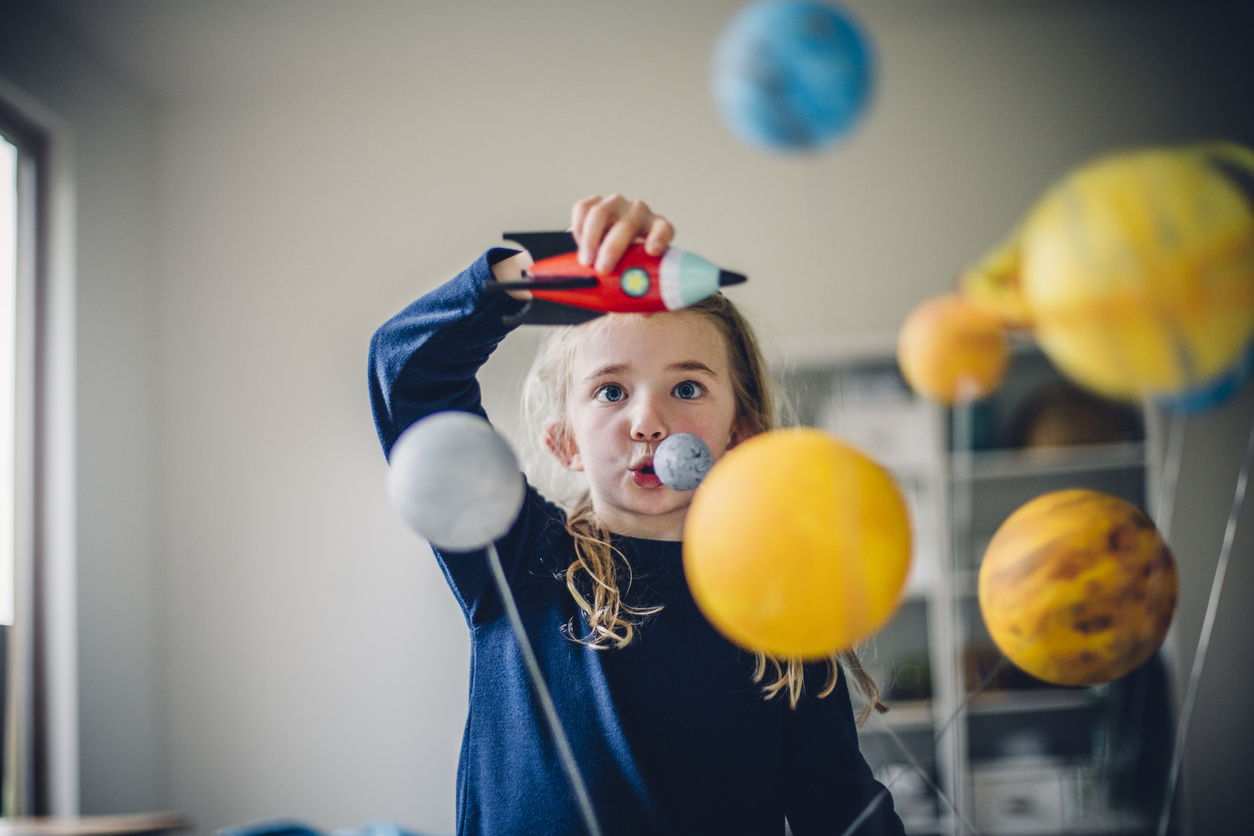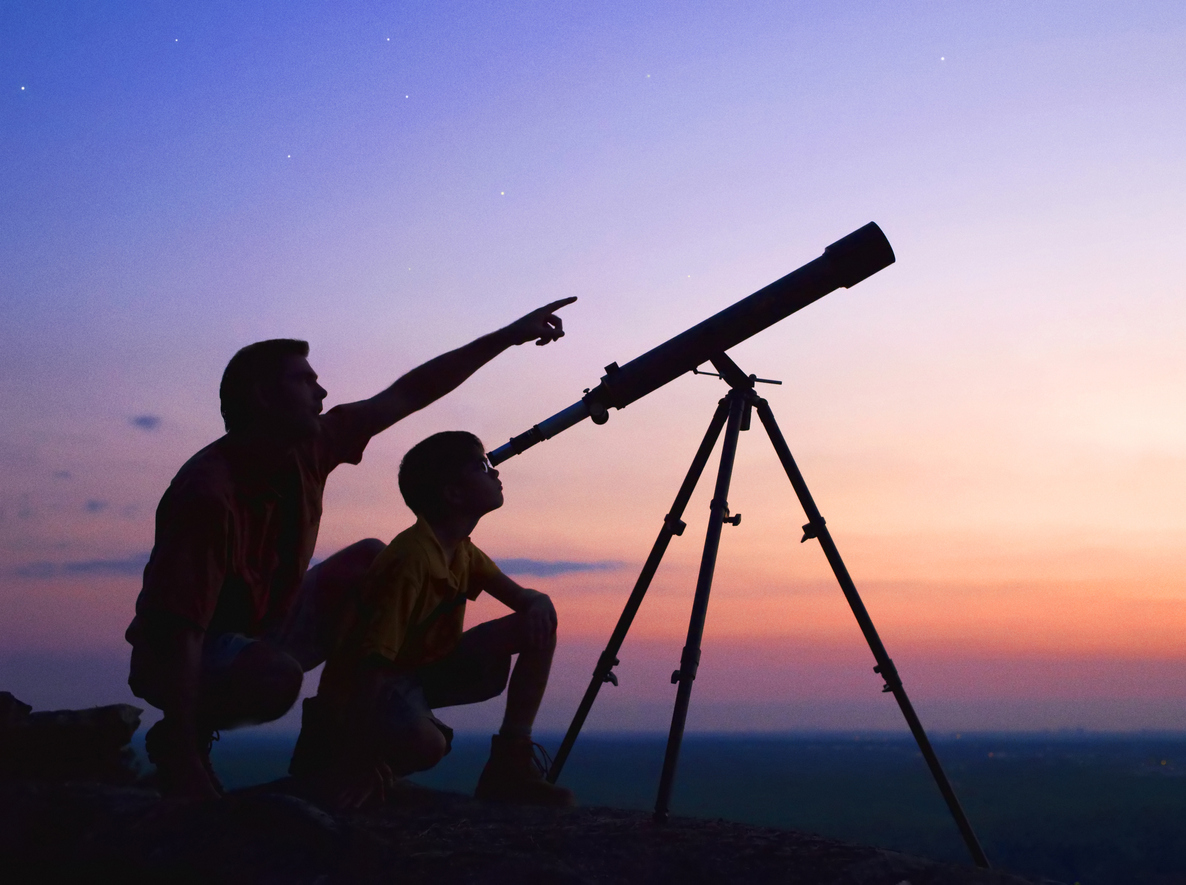World Space Week: Encourage Your Toddler to Master Astronomy

Your toddler will shine this World Space Week by having a blast with these activities that are fact-checked by an astronomer!
Every year from October 4th through to October 10th, nearly 100 countries around the world celebrate the United Nations World Space Week. (WSW). World Space Week is a festival of space-themed activities for all ages put on by the World Space Week Association, (WSWA) local educators and organizations, and individuals just like you. Different years have different themes. In 2022, the theme was ‘Space and Sustainability.’ You can read more about WSW at worldspaceweek.org.
You don’t have to be an expert to participate in World Space Week, and it doesn’t have to be the second week in October for you to try out these activities! Even if you don’t know anything about space and sustainability, outer space, or the space sector in general, you and your kids can have a ton of fun participating.
And you may even learn something new!
Why Is Space Exploration Important for Toddlers?
Toddlers often grapple with questions and concepts about how the universe works, from why the sun shines to finding out that their shadow isn’t ‘real.’ Learning about outer space, the planets, and the universe can give those hungry minds something to chew on.
Basic space science may not answer all of your toddler’s questions, but it can be a starting point for all sorts of discussions. And an interest in space can turn into a lifelong passion, or even, one day, a career. It’s especially important to teach young girls about the importance of women in space and women in science in general.
And there’s more.
From a developmental perspective, one of the most critical cognitive milestones for preschool-aged children is developing empathy. What does this have to do with space education?
In order to develop empathy, people need to learn to look beyond their own experiences. The photos of Earth from the first moon landing did this on a large scale, giving humanity a new perspective on our place in the universe, and supercharging the environmental movement, too.
Finally, thinking about other worlds can not only spark your child’s imagination but can also get your kids thinking about the betterment of their own world.
How Do You Inspire Kids to Learn About Outer Space?

A lot of young people are obsessed with space and the planets. But not everyone has an immediate interest, and that’s fine.
We have a list of space activities that can teach and entertain the youngest learners to high school students, from art projects to science experiments and more. But here are our top ways to get your toddler inspired.
1. Visit the Planetaria
Planetariums have exhibits, shows, and space-themed activities for people of all ages. It can make for a fun day out for you and your toddler. If you’re looking for a Space Week event, your local planetarium could be an excellent place to start.
If there’s a university or community college in your area, chances are, it has a planetarium. You can also check the Worldwide Planetarium Database to find one near you.
2. Get Illuminated with This "Phases of the Moon" Activity
Why does the moon look different at different times? What’s on the dark side?
The answer is that the moon isn’t changing, but our view of it is.
There’s only one source of light in our solar system: the Sun. When you see the moon’s “light” parts, that’s where the sunlight is reflecting off the moon’s surface.
The moon travels around the Earth, and, like the other planets in our solar system, the Earth and the moon travel around the Sun. It’s no wonder that the patterns of light and shadow, as well as the moon’s craters, look different at different times.
It may seem complicated, but there are simple ways your child can get to grips with this concept. In fact, you can model the changing view of the moon with just a ball and a lamp (or even your child’s fist).
- Put the lamp in the middle of the room.
- Have your child hold the ball at arm’s length. Explain that your child is the Earth, and the ball is the moon.
- Turn the lights off (or down), except for the lamp.
- Have your child rotate in a circle, holding the ball at arm’s length.
This way they can observe the eight phases of the moon. If you need a little help, watch how it’s done!
If you want to learn more about the moon and its phases, check out NASA’s user-friendly explanation.
3. Go For a Star Walk
The simplest way to observe space is to go for a nighttime walk. On a clear night, you can observe the night sky, and see stars and other celestial bodies, and if you're lucky, you might even see a meteor shower.
Before you leave to go for your walk, learn a little bit about the constellations. Constellations are groups of stars that some people think resemble people or animals. Look for the Big and Little Dippers, for example, or Orion’s belt.
Older kids may enjoy learning about how to find the North Star (Polaris), and from there, how to navigate via the stars.
4. Download a Night Sky App
What if the weather or light pollution make it hard to see the stars? Never fear. There’s an app for that.
Sky Map is like a planetarium in your pocket. You simply point your phone’s camera toward any point in the sky, and Sky Map will show you what’s out there. You can view constellations, stars, and planets, check out a nebula, spy a comet, and more. It even works indoors.
And it’s free.
NASA itself has dozens of fun apps, including an app for making space selfies, and one that provides a virtual tour of the moon.
5. Watch the Moon Landing
On July 20, 1969, people around the world stayed up late watching the first humans land on the moon. NASA has restored the original video so that you can watch it too.
Three hours may be too much for younger kids, but you can watch the highlights in this two-minute video.
6. Build a Spaceship or Spacee Station
A lot of kids love to play the role of an astronaut in a space expedition. Building your own space station, space shuttle, or spaceship to play in can be both fun and educational. It doesn’t have to be complicated, and you can make your spacecraft from things you probably already have at home.
Here are a few things to think about:
- Where do astronauts eat and sleep?
- How do they go to the bathroom?
- How do they eat, sleep, and go to the bathroom in zero gravity?
- What does a spaceship look like on the inside?
- What’s on the outside to protect the craft from the dangers of space?
- What are those dangers?
- How does a spacecraft power itself?
- How do astronauts communicate with people on Earth?
Here are some resources to get you started:
- An Inside Look at the International Space Station
- Learn about the different space shuttles
- Build a spaceship with NASA
7. Host a Space Event or Planet Party
Hosting a planet-themed party is an opportunity to learn about the other planets: Venus, Jupiter, Mercury, Neptune, Uranus, Pluto, Mars, and Saturn.
Your guests can go all out with planet-themed costumes, or keep it chill with crayons and free printables. You can even cook up some space-inspired goodies.
You can also adjust the learning and activities for guests’ ages and learning levels.
Do you have your own ideas? We bet you do! Why not create your own World Space Week event at your child’s school or your local community center?
More Resources for Caregivers

If you want to learn more about space yourself, the internet can be a great place to start.
Outreach is an important function of NASA, the US Space Agency. NASA’s Space Place is a special site for kids and the people who love them. It’s filled with activities and ideas for learning.
Older kids may want to check out NASA’s official website, as well as their social media.
You can also visit the website of your local university or community college. Astronomy clubs sometimes have public events, and many are both free and appropriate for young learners.
Stargazing nights give toddlers an opportunity to ask all the questions they like from real scientists. Older kids may get a chance to ask about careers and study programs in astronomy and related fields.
Offline, why not hit the books?
DK Publishing has a huge number of gorgeously illustrated books about all sorts of things, from science and nature to history and culture. Toddlers will love looking at the pictures while you read the captions. We recommend their First Space Encyclopedia as a launch point!
Are You Ready to Explore?
You don’t have to wait for World Space Week. Get started on your outer space adventure now!

